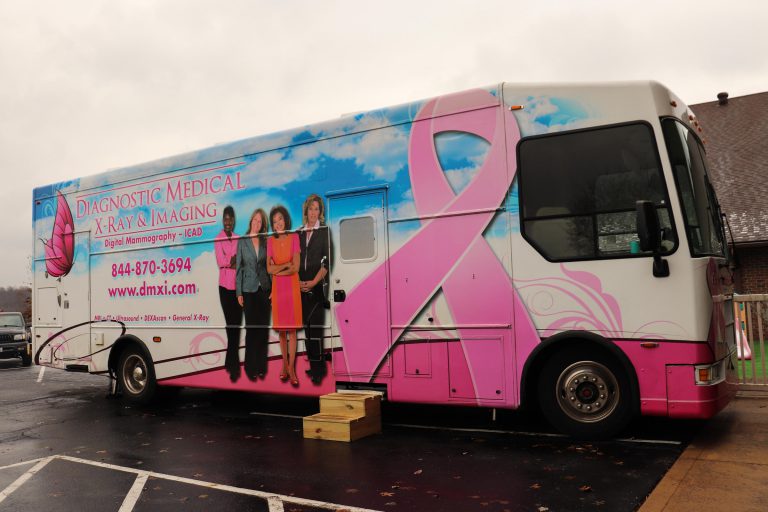The Midwest is home to one of the largest Amish populations in the nation. And many of these settlements overlap with rural Appalachian counties, where access to healthcare is hard to come by. But a project in Ohio aims to help by bringing cancer screenings to Amish women.
Valerie Rice is a mammographer and she’s dressed like one, too. Her shirt is covered in pink breast cancer awareness ribbons.
As she shows off her exam room, she says, “It’s a typical mammogram room. If you went to a hospital it would look exactly the same. … It’s nothing really different, except that it’s in a moving vehicle.”
This exam room is on wheels — a large bus, pink, of course.
Today the mobile mammography unit is parked at the Mennonite Christian Assembly Church in Fredericksburg, Ohio, within a buggy ride’s distance from some of the state’s largest Amish settlements. Snow is falling in the parking lot, and horses are tied up to poles in the frozen ground.
Melissa Thomas organizes mobile clinics like this one about 25 times a year. She’s the director of the Center for Appalachia Research and Cancer Education, which focuses on cancer disparities in the Amish and Mennonite communities.
“We like to bridge the gap between the culture of Amish and Mennonite communities and the culture of health care,” she says. “So we try to find screening locations that are in the most remote sections of the state, that are serving more than likely a more conservative group of Amish that may not have access or availability into the local hospital systems.”
The majority of Ohio’s Amish settlements are in Appalachian counties, where cancers that can be detected by preventative testing occur at higher rates.
There is little data available on the Amish, but Thomas says what she has found in her own research of Ohio settlements is startling.
“What really surprised us was the higher death rate of breast cancer among Amish women in these two regions,” she says. “What was disturbing to us is that the leading cause of death of Amish women under 60 was breast cancer. ”
Beyond distance, there are other reasons Amish women underutilize screening tools like mammograms. There’s a language barrier; some in the community are more comfortable speaking Dutch or German than English.
Cost also can be an impediment. The Amish don’t participate in the health insurance market, instead pulling money for procedures from a group fund.
Plus many Amish women say they don’t know what resources are available.
“That was the way with me, when I had my diagnosis,” says 80-year-old Ella Miller. “What do I do? Where do I go? I felt like being out in the boonies about it.”
The Amish woman, a 30-year survivor of breast cancer, is a community health worker with the project.
“People think a mammogram will cause cancer. It’s very hard to get that out of their mind,” she says.
Research shows the majority of Amish women underestimate breast cancer risk and are more likely to believe that sort of myth.
Miller says that makes it difficult to get the women in the door. In nearby Holmes Co., a community health assessment found that about 60 percent of non-Amish residents had had mammograms, while only 20 percent of Amish woman had.
If they receive a positive test results, it can be even more difficult to encourage them to seek medical intervention.
“There are some people that think that is meant to be, and that is God’s plan for their life,” Miller says. “And there are those that refuse treatment, whatever, and they don’t seek treatments that this is what God meant for them in their life. And whenever their life ends, so be it.”
She feels her mastectomy years ago gave her a chance to fulfill her greater purpose: to help other women in her community.
“You should still do what needs to be done so God can heal you,” she says. “Because you need to help yourself, somewhat. Yes, God will help you, but you also have to do your part.”
After a diagnosis, the project helps connect women with nearby hospital systems for further care. Then, the mobile clinic rolls on to another settlement in the state.
This story was produced by Side Effects Public Media, a news collaborative covering public health.
9(MDM5MjE5NTg1MDE1Mjk1MTM5NjlkMzI1ZQ000))

